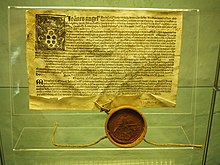Indulgence letter


The letter of indulgence attested the purchaser an indulgence , that is, the "remission of the penalties imposed that are still to be served by the sinner after his repentance". Other names are indulgence letter (from Latin litterae indulgentiales ), indulgence sheet or, especially with a larger part of the picture, indulgence picture . The letter of indulgence should not be confused with the indulgence privilege for a pilgrimage church.
Formally, the letter of indulgence is one of the single-sheet prints made and sold by letter painters in the 15th century as woodcuts or copperplate engravings with Christian representations and accompanying prayers .
The letter of indulgence was issued in the name of a bishop or cardinal commissioned by the Pope , with the church granting buyers a discount in terms of temporary penalties or a complete indulgence. In the late Middle Ages, there was great demand for collective indulgences awarded by several bishops at the same time, because the faithful assumed that the number of days granted would multiply by the number of exhibiting bishops. In contrast, a bull of indulgence was issued by the Pope himself. Conditions were the performance of certain prayers (for example with a rosary ) or godly works (such as donations for the building of churches). In the course of the distribution of these letters, the Dominican Johann Tetzel played a special role, especially with the famous sentence: "When the money rings in the box, the soul jumps out of the fire."
For Martin Luther , the practice of using letters of indulgence to finance the construction of St. Peter's Basilica in Rome, for example , was one of the main points of criticism of the Catholic Church and ultimately motivated him to write the 95 theses .
On February 8, 1567, Pope Pius V abolished all alms indulgences in the Etsi Dominici constitution and on January 2, 1570 in the Quam plenum constitution, the excommunication for those who wanted to trade in the indulgences, which is still in the Codex Iuris Canonici of 1917 to Can. 2327 led to the penalty of excommunication.
literature
- Raimond Pérault: Letter of indulgence . Palatinate State Library, Speyer 1990 (facsimile of the Speyer 1490 edition).
- Alexander Seibold: collective indulgences. Deeds of indulgence from the late Middle Ages and the early modern period . Böhlau, Cologne 2001, ISBN 3-412-12099-5 (also dissertation, University of Regensburg 1999).
Web links
Individual evidence
- ↑ Duden: German Universal Dictionary . Bibliographical Institute (Dudenverlag). Mannheim (6th edition 2007) ISBN 978-3-411-05506-7 .
- ↑ Enno Bünz, Hartmut Kühne: The indulgence in the everyday piety of the late Middle Ages . In: Martin Sünder, Helge Wittmann (Red.): Piety in writing and images. Illuminated collective indulgences in medieval Mühlhausen . Imhof, Petersberg 2014. ISBN 978-3-7319-0039-9 . Pp. 9-14.
- ^ Karl Eduard Vehse : The world history from the standpoint of culture and national characteristics , Volume 2, Walther, 1842, p. 56.